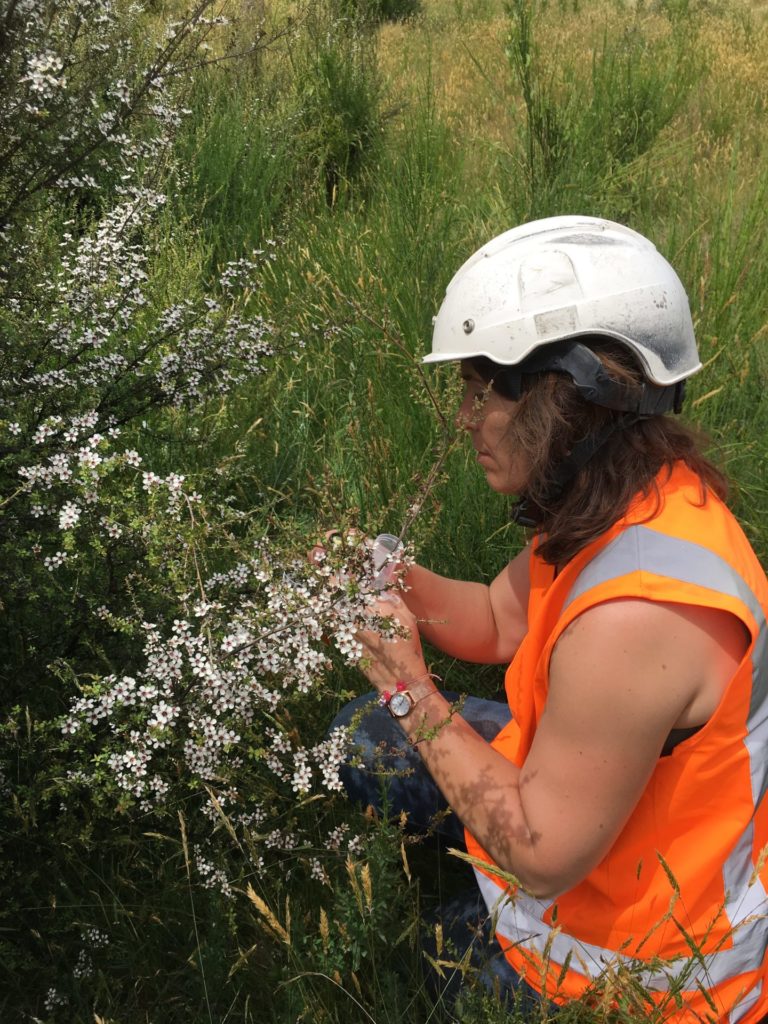Microscopic epiphytes may help in the war against myrtle rust
By Beyond Myrtle Rust.
If you walk through a tract of native forest in New Zealand, you will no doubt notice plants growing on the trees. These are epiphytes, a name given to organisms that grow on the surfaces of plants. Epiphytes are plentiful and varied in New Zealand and include the Kahakaha – also called the Perching Lily (Collospermum hastatum) – as well as a number of orchids, mistletoes and other plants.
But plants aren’t the only epiphytes living on native trees. There are also hundreds of epiphytic microbes. In spite of their small size, epiphytic microbes are important to the health and wellbeing of native plant communities. Collectively, these fungi, bacteria, and viruses form the ‘microbiome’ occupying plant surfaces.
“For a lot of our myrtaceous species, the microbial story is a big story,” says Hayley Ridgway, a microbiologist at Plant & Food Research and member of the Beyond Myrtle Rust programme. “Epiphytic microbes are highly active and contribute to the community ecology of our forests.”
Ridgway is part of a large interdisciplinary and interinstitutional team interested in the association between native plants and their microorganisms. She believes that the microbes living on New Zealand’s native plants could hold the key to resisting the spread of myrtle rust.
Ridgway and the team have identified a large number of epiphytic microbes from the microbiomes of ten myrtaceous species, including mānuka, ramarama, and pōhutakawa.

“Differences in the microbiome of each plant species could be the reason why some species are more resistant to myrtle rust than others,” says Ridgway.
Microbial communities may even be different within the same plant.
“Myrtle rust attacks new growth, like new leaves, more quickly than old growth,” says Ridgway. “That has to do with the phenology of the plant, but may also be the result of differences between the microbial groups in those two leaf types. Younger leaves have less developed microbiomes than older leaves.”
Whether at a plant level or species level, differences in microbial communities will give the team more information on where to start looking for novel biocontrol agents.
“Some microbes are biologically active and make chemicals that could affect the ability of myrtle rust to infect plant tissue,” says Ridgway.
Ridgway’s work is part of a larger effort within the Beyond Myrtle Rust research programme to find biocontrol agents for myrtle rust. A Plant & Food Research team in Ruakura is looking at known and commercially available biocontrol agents, whereas Ridgway’s goal is to find a local solution from the microbiomes of New Zealand’s native plants.
“We’ve already identified some bacteria derived from native plants that produce inhibitory compounds towards the rust,” says Ridgway.
One of these compounds hinders germination of rust spores.
“In the lab, we can inhibit germination from 100% down to about 20%,” says Ridgway.
When more microbes are found that produce inhibitory compounds, experiments can progress from lab-based testing to whole-plant testing. If a microbe or suite of microbes are found to effectively combat myrtle rust, a biocontrol can be developed.
“The ultimate goal is to seed areas with biocontrol agents that naturally live on the surface of the plants to enhance resilience of a site towards myrtle rust,” says Ridgway. “This will help the plants use their mouri (vital essence) to overcome myrtle rust naturally.”
While the development of a native biocontrol agent is still in process, this research is already contributing new information to the field of microbiology.
“The ecology of microorganisms associated with native plants is still understudied in New Zealand,” says Ridgway. “Even just describing some of what’s there has improved our understanding of how microbes interact with plants.”
Posted October 2020.